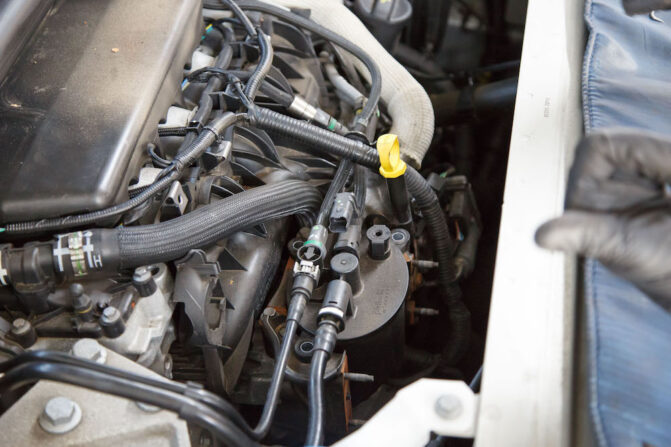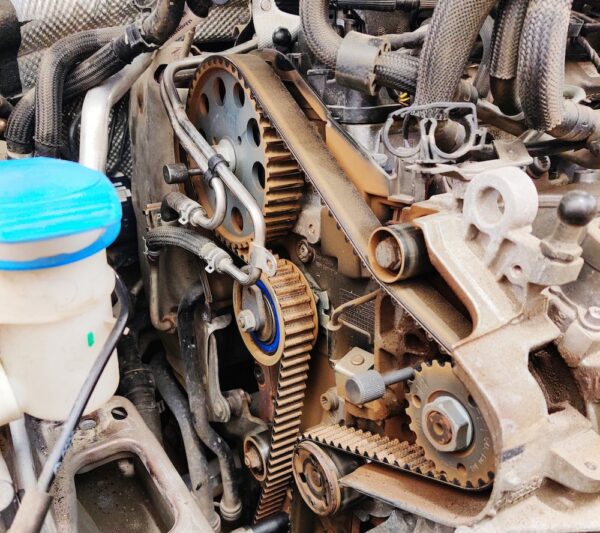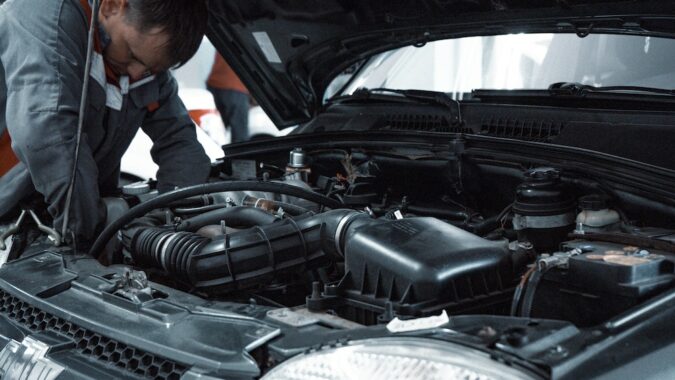The crankcase breather is part of your engine’s positive crankcase ventilation (PCV) system. It’s not a system that we talk about often, but it’s crucial for the smooth operation of your engine. Additionally, it helps to prevent serious problems. This post will talk about the crankcase breather and everything you need to know about it:
What’s A Crankcase Breather?
Before we continue, there’s something we should clear up: when talking about the crankcase breather, some people may actually be referring to the valve cover breather. These two devices serve similar purposes, in the sense that they help to relieve pressure inside the engine’s crankcase.
However, they are two different components and they work differently. This post will mainly discuss the crankcase breather, but we’ll touch briefly on the valve cover breather as well.
The crankcase breather consists of the breather filter and several hoses. The filter is sometimes referred to as a PCV filter or the crankcase vent filter depending on who you’re asking. But to further understand the crankcase breather and how it works, we need to explain how the PCV system works and why it’s necessary:
How The Positive Crankcase Ventilation Works
All internal combustion engines inherently have blow-by gases. Blow-by gases refer to the gases that the engine produces during the power stroke that escapes through the piston rings and enters the crankcase. Ideally, these gases should’ve escaped through the exhaust valves to be filtered by the exhaust system.
Anyway, the crankcase is the lower construction of the engine. As the name suggests, this houses the engine’s crankshaft. Additionally, it’s also where the engine stores some of its oil. As mentioned, blow-by gases can escape through the piston rings and will enter the crankcase.
This isn’t ideal since the gas can create excess pressure. This will eventually lead to several engine problems. In the past, engines would just let these gases out via a hose from the valve cover. This isn’t environmentally friendly since you’re releasing unfiltered toxic gases into the atmosphere.
So, the eco-friendly solution to this problem is to use a positive crankcase ventilation system or PCV. The PCV directs these gases out of the crankcase and feeds them back into the engine. Rather than expelling the toxic gas, it reuses them for the engine. This is why the PCV is considered a part of both the intake and emissions control system.
If you were wondering, the reason why we call it a Positive Crankcase Ventilation system is because the blow-by gases create a higher than atmospheric pressure in the crankcase, otherwise known as positive pressure. Hence why we call it a PCV because the system ventilates the positive pressure out of the crankcase.
How Does The Crankcase Breather Work?
Where does the crankcase breather come in then? Well, the problem with the PCV is that it can result in negative pressure (vacuum) inside the crankcase, which is not something you want either.
This is where the breather comes in: it takes in fresh air into the crankcase. This ensures very little vacuum is present in the crankcase. Additionally, it helps to force the blow-by gases to escape through the PCV hose and valve into the engine. Here’s a video about how the PCV and breather system works:
The video above doesn’t state which one the breather is in its drawing. But it’s the filtered air that comes into the crankcase after the MAF sensor in the car’s air intake system.
There are two types of crankcase breathers. In modern cars, the crankcase breather is a hose that connects to the air intake system after the Mass Air Flow (MAF) sensor. The breather usually consists of a hose that lets air flow into the crankcase. And a filter that filters debris before the gases enter the PCV valve.
In older cars, the breather is independent of the air intake system. It has a separate hose and a filter that sits on top of the hose. This filter is usually located on the side of the engine. However, the principle is the same: it takes air into the crankcase to manage pressure and forces blow-by gases to escape the crankcase.
Over time, damage may occur to the breather hose. The crankcase ventilation filter will also clog due to dirt and debris. This affects the airflow into and out of the crankcase and ultimately affects the operation of the PCV system. As we’ll discuss later on, this can lead to a myriad of serious issues.
What’s A Valve Cover Breather?
The valve cover breather is a filter that you install on the engine’s oil filler in place of the cap. It sits on top of the valve cover, hence why they call it a valve cover breather.
The purpose of the valve cover breather is to allow crankcase pressure to escape. Rather than taking air in, the breather instead only allows gases to flow out. This is meant for older cars that don’t have a factory PCV, so it can allow crankcase pressure to escape. It may also be beneficial for cars with aftermarket turbochargers.
This is because the turbocharger can cause higher pressure in the intake system. As a result, your PCV won’t open as frequently due to the pressure, allowing pressure to build up in the crankcase. The valve cover breather helps to relieve pressure from the crankcase without the help of the PCV.
Signs You Have A Bad Crankcase Breather
So, the crankcase breather is there to supply fresh air into the crankcase. This ensures the correct amount of pressure (which is a slight negative pressure) in the crankcase. And it also helps the PCV to operate and recirculate blow-by gases into the engine.
As you can imagine, with such a crucial role to play, there are going to be noticeable symptoms when you have a bad crankcase breather. These are the symptoms you might see:
1. Oil Leaks
The most common and noticeable symptom is oil leaks. This is usually a sign of a clogged filter. As mentioned, the filter, well, filters out debris in the blow-by gases before they flow back into the engine via the PCV valve.
A clogged filter will restrict airflow out of the crankcase, leading to less than the optimal flow of the blow-by gases. This will lead to a buildup of pressure inside the crankcase and eventually leads to various gaskets and seals blowing and causing an oil leak.
The leak can happen anywhere, it largely depends on the condition of the seals and gaskets. The ones that are the most worn are likely to blow first due to the pressure and leak oil out. Oil leak commonly happens at the oil pan (bottom of the engine) or the valve cover (top of the engine).
However, it may also happen at the timing chain cover, or at the front and rear crankshaft seals. Note that these gaskets and seals have their lifespan, so they may be leaking oil because they’re at the end of their lifespan, and not because of pressure buildup in the crankcase
You’re going to have to take a closer look and identify where the leak is coming from. Afterward, check how long the gaskets and seals are supposed to last. For example, the oil pan gasket can last for up to 10 years. Meanwhile, the valve cover gaskets typically last for about 50,000 miles.
If the gasket fails before its predicted lifespan, it’s a good indication that you have a crankcase pressure problem that’s causing them to fail early.
2. High Or Rough Idling
A car usually idles at around 600 – 900RPM, although some cars may idle at around 1,200RPM when you turn on the air-conditioning system. Also, note that idling at around 1,200 – 1,500RPM for a brief period when you start the car in the morning is normal.
However, after the car warms up the RPM is supposed to drop. Additionally, it should maintain a constant idling speed. If the car idles high or is rough, this is usually because of a vacuum leak in the air intake system.
An internal combustion engine needs to maintain a certain pressure in the engine. This allows the fuel, air, and spark to work properly and combust fuel at the right time. If there’s a vacuum leak, then this process will be disturbed which can affect the car’s idle.
If the crankcase breather’s filter is clogged, it may cause a vacuum leak which in turn causes the car to idle higher and/or rougher than usual.
Keep in mind that other parts can also cause a vacuum leak, such as a broken vacuum line which usually causes a hissing noise. So, this isn’t a sure sign that you have a crankcase breather problem. Read our article about vacuum leaks to learn more.
3. Occasional Performance Drops
The next symptom you might notice is an occasional performance drop. However, this is sometimes barely noticeable and, well, happens occasionally. But how does the crankcase breather affect performance?
Well, as mentioned, the PCV recirculates the blow-by gases inside the crankcase into the engine. This means that a portion of the air mixture in the engine is supplied by the PCV, along with fresh air from the air intake system and the Exhaust Gas Recirculation (EGR) system.
If, for example, the breather filter clogs up, then it can restrict airflow into the PCV. And ultimately reduces airflow into the engine. Since the engine ideally should run on a stoichiometric ratio (14.7kg of air to 1kg of fuel), this will cause the engine to make adjustments due to the lack of air supply from the PCV.
This will force the engine to either reduce the amount of fuel it puts in or take in more air via the air intake system. The solution will depend on the programming of the Engine Control Unit (ECU). Either way, there’s going to be a brief moment where the engine isn’t getting enough air, causing occasional performance drops.
Now, there is a myriad of possible causes that can cause the engine to lose performance. And that is why the next symptom is a saving grace when it comes to diagnosing this problem:
4. Check Engine Light
We all dread the check engine light, but it is actually a blessing in disguise. A check engine light means your car’s On-Board Diagnostic (OBD) system has registered a trouble code. These codes are registered when the ECU detects an issue with the engine that it can’t fix on its own.
If you see a check engine light, this means you can plug in an OBD scanner into the OBD port and see what the trouble codes are. These trouble codes won’t tell you exactly which component is faulty. But it will tell you what problem the engine is having, and it helps to narrow down the potential causes and makes the diagnosing process easier.
Keep in mind that we’re referring to the OBD-2 system, which is a universal diagnostics system that all cars use since 1996. Cars before 1996 have an OBD-1 system, and they’re proprietary meaning the method to use it differs depending on the manufacturer. Anyway, here’s how to use an OBD-2 scanner:
The codes you’re likely to see are the P051F and P051E if you have a crankcase breather problem. Here’s what the codes mean:
- P051F – Positive Crankcase Ventilation Filter Restriction.
- P052E – Positive Crankcase Ventilation Regulator Valve Performance.
Both codes are triggered when the crankcase pressure (CKP) sensor detects an abnormal pressure value inside the crankcase. However, the P052E code is more likely to be a PCV valve issue. Meanwhile, the P051F may also be a PCV valve issue. But it can also indicate a clogged filter or damage to the breather hoses.
How Do I Troubleshoot The Crankcase Breather?
If you suspect you have a crankcase breather problem, how do you verify it? Well, the only thing that you can do is inspect the breather hoses and filter for any signs of clogging or damage. Unfortunately, the location of the breather will differ depending on your car’s make and model.
Our recommendation is to take the car to a trusted repair shop and have them diagnose the problem. Troubleshooting this on your own will require you to take apart some components of the engine, and will take some time and skill.
Now, let’s talk money…
Crankcase Breather Repair Costs
The cost to repair crankcase breather problems will depend on the parts you need to replace. Additionally, the design of your engine will also affect the labor cost.
The two parts you typically need to replace are either the filter or the hoses, or both. And both parts are not too expensive. The filter is usually somewhere around $10 -$80. Meanwhile, the hose is usually between $15 – $50. However, note that the filter may be part of a larger assembly. If this is the case, expect the cost to be much higher.
As for the labor, this job usually takes about an hour or so to finish. Most auto repair shops will charge between $80 – $120 per hour. However, if your engine is more complex, it may take up to two hours to do the job.
Overall, you can expect to pay between $90 – $200 to replace the filter. While the breather hose will cost between $95 – $170 to replace.
Can I Replace It Myself?
The job is doable since it doesn’t require specialized tools, and access to the components isn’t difficult. However, the problem is this isn’t a component that’s often discussed. So, you might have trouble trying to find the correct guide for your car’s specific make and model.
The example above from 1A Auto is one of the few guides we can find on how to replace the crankcase breather hose. We recommend watching the video above to understand the process, but here’s the gist of it:
- Locate the breather hose. You will likely need to remove the engine’s cover first.
- Remove the hose clamps.
- Remove the top connection of the hose, then pull it out from the bottom connection.
- Install the new breather hose – this is where the steps are likely to differ greatly depending on your car’s make and model.
- Reinstall hose clamps, you may need new ones depending on the hose clamp design.
Note that the example above is for a Volvo XC90, your car is likely to be different. Overall, we don’t recommend doing this job yourself unless you’re absolutely sure of what you’re doing.
Crankcase Breather FAQ
Still, have questions about the crankcase breather? Here are some answers you might be looking for:
Can I Drive With A Bad Crankcase Breather?
If you don’t see the symptoms just yet, you can. But once you see a symptom, especially an oil leak, you should repair the leak and inspect your crankcase breather. If it turns out you have a bad crankcase breather, then you need to replace the bad parts. Otherwise, oil leaks and other problems can reappear very quickly.
Oil leaks are not to be taken lightly. If your engine doesn’t get enough oil, it won’t be able to properly lubricate itself. This will result in excess friction between components, which leads to overheating, and eventually, damage to these parts. If you have internal engine damage, you can expect to pay at least $1,500 for an engine rebuild.
So, as it usually is with any engine problems, you shouldn’t postpone repairs. Best to repair them while they’re cheap before it turns to an expensive engine rebuild job that costs thousands of dollars.
Is The Crankcase Breather The Same As PCV?
The crankcase breather is part of the Positive Crankcase Ventilation (PCV) system. When talking about PCV, people usually refer to the PCV valve which opens and closes to allow blow-by gases to escape from the crankcase. But the PCV system consists of several components.
Another component of the PCV you might be interested in is the oil separator filter, or some people might refer to it as the oil catch can. This part is necessary so that the PCV valve can separate the oil vapors (since some oil is stored in the crankcase) from the blow-by gases.
Ensuring that none of them enters the engine, which isn’t ideal. In most cars, the oil separator is built into the PCV valve itself.
How Much Does A PCV Valve Replacement Cost?
The PCV is a relatively simple device and therefore quite cheap to replace. The part itself is around $20 – $30 for most cars, while the labor to replace them usually costs about $80. In total, expect to pay between $100 – $110 for a PCV valve replacement cost.
Note that the PCV is only one of several emissions systems in your car. Other important emissions systems include the Evaporative Emission Control system (EVAP), Exhaust Gas Recirculation (EGR), and the secondary air injection system.
These systems are crucial for the smooth operation of your car. Additionally, they make sure your car meets emissions regulations (for more insight, check out our explainer on do you need a catalytic converter). You can learn more about them in our guide to the emissions system in a car.
Do I Need A Valve Cover Breather?
Unless your car doesn’t have a PCV system or has an aftermarket turbocharger, you don’t need a valve cover breather. Even most cars with aftermarket turbochargers don’t really require them. Some people have stated that they don’t see any meaningful effect.
If you want to experiment with it, it’s quite cheap. They’re usually no more than $10 – $20, and you can easily install them; simply remove your oil filler cap, and then twist in the valve cover breather. It’s probably just going to be a waste of your $20 though.
Facts about the Importance of Crankcase Ventilation System
- The crankcase ventilation system is crucial in preventing oil sludge build-up, oil leaks, and oil consumption.
- The pressure created by churning oil, piston rings, and valve guides has to go somewhere, and without a ventilation system, it can blow out gaskets.
- Modern engines use a Positive Crankcase Ventilation (PCV) system, which draws out the “dirty” air through a PCV valve connected to the intake manifold by a hose.
- The PCV system sweeps away fumes and vapor, keeps the engine clean, and releases pressure without causing a leak while improving emissions.
- PCV hoses must stay clean and clear, following the maintenance schedule to extend the engine’s life and oil.
- The PCV system helps improve the seal of piston rings and valve stems, which keeps the compression in the chamber and reduces windage and oil aeration.
- For racing vehicles, a Crankcase Evacuation System vents fumes into the exhaust system, and Racing Vacuum Pumps create a high vacuum in the crankcase for dedicated racing vehicles with big cams and low engine vacuum.
- A Crankcase Evacuation System is not recommended for vehicles with mufflers as it can cause a fire due to oil collection in the muffler.
- The PCV system is legally required for emissions purposes for most street cars.
- A PCV system is essential in reducing drag on the rotating assembly, thus enhancing engine performance.
Crankcase Breather: Wrap Up
To summarize, the crankcase breather is a hose that takes in fresh air and directs them into the engine’s crankcase. This fresh air helps to regulate pressure within the crankcase, which ideally should be very slightly negative (vacuum).
Additionally, it also helps to force blow-by gases inside the crankcase to escape via the PCV hose, through the PCV valve and then feeds it back into the engine. The PCV system is a device that helps your car to reduce emissions and be environmentally friendly.
The crankcase breather will usually require you to replace the hose or filter over time, both of which costs up to $200 to replace including labor. It’s important to keep them working well as it can cause oil leaks and performance issues.
Additionally, it will help to maintain the condition of the PCV. You’d want to ensure the PCV is in good condition and working properly as a bad PCV can cause your car to have performance issues and fail to pass an emissions test. Hopefully, this has been a helpful article for you.




